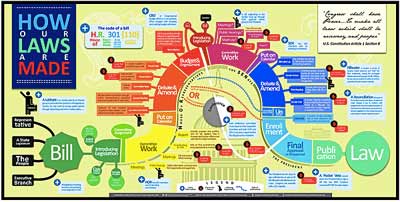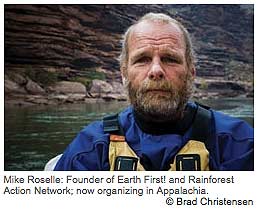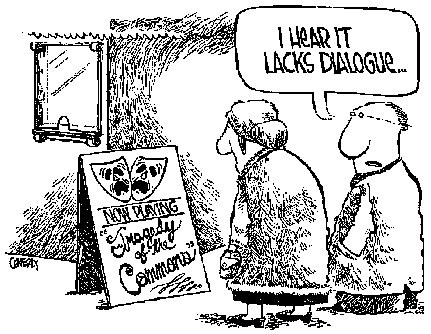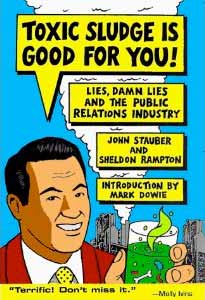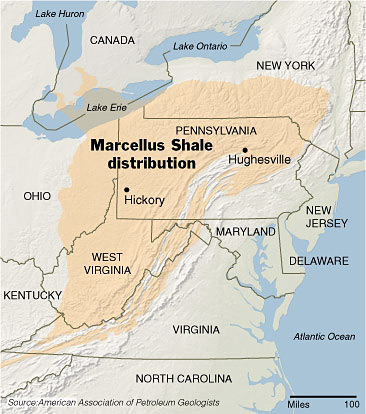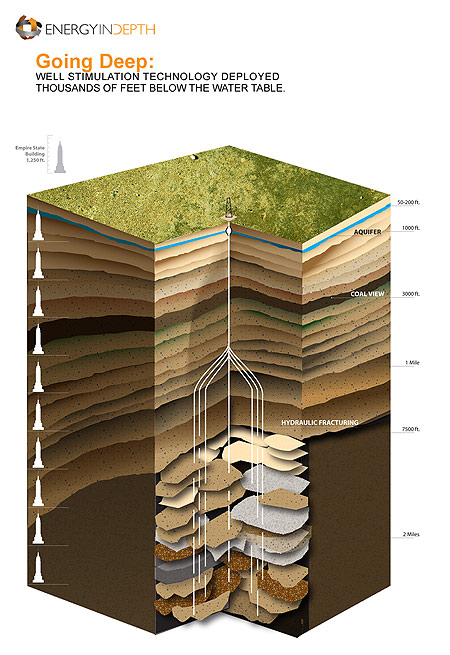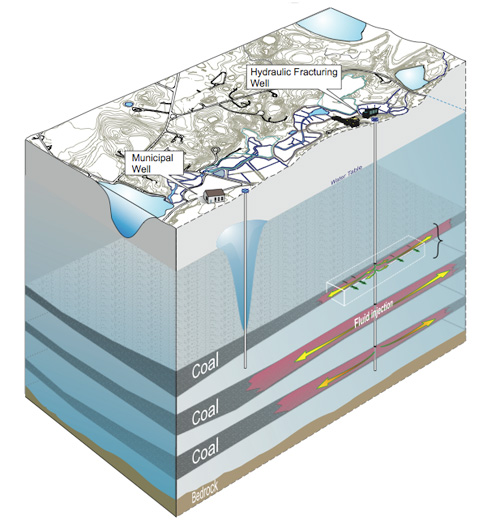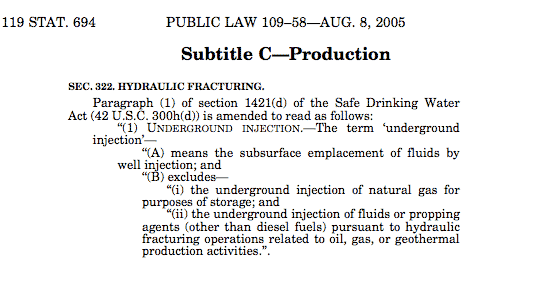Biblio

Sen. Robert Casey
S.1215. 6/9/2009. `Fracturing Responsibility and Awareness of Chemicals (FRAC) Act'. Sponsor: Sen. Casey, Robert P., Jr. [PA], Co-Sponsors in alphabetical order: Sen. Cardin, Benjamin L. [MD], Sen. Feinstein, Dianne [CA], Sen. Gillibrand, Kirsten E. [NY], Sen. Sanders, Bernard [VT], Sen. Schumer, Charles E. [NY].
Referred to Senate committee. Status: Read twice 6/9/2009 and referred to the Committee on Environment and Public Works.
See House Bill: H.R. 2766. 111th Congress. Rep. Diana Degette. Rep. Maurice Hnchey, et al. Fracturing Responsibility and Awareness of Chemicals Act of 2009 - Amends the Safe Drinking Water Act to: (1) repeal the exemption from restrictions on underground injection of fluids near drinking water sources granted to hydraulic fracturing operations under such Act; and (2) require oil and gas companies to disclose the chemicals used in hydraulic fracturing operations. (6/9/2009).

Rep. Diana Degette
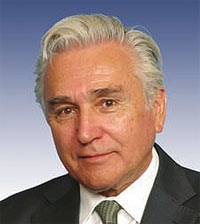
Rep. Maurice Hinchey
See: CIVICA: Centrist & Independent Voters in Coalition for America. "How out Laws are Made." 2011-04-09.
The U.S. Chamber of Commerce is controlled by Big Polluters, poisons politics with its dirty money, and opposes every single effort to curb climate pollution.
“The U.S. Chamber Doesn’t Speak For Me” campaign is designed to expose the Chamber’s dirty business in Washington D.C., and discredit their efforts to delay the kind of bold action we need to create a clean energy economy and a safe climate future.
For more information, check out their Frequently Asked Questions page.
See: Eaarth: Making a Life on a Tough New Planet | 350.org Founder Bill McKibben
See: As climate crime continues, who are we sending to jail? Tim DeChristopher?

U.S. Environmental Protection Agency (EPA MOA). 2003. A Memorandum of Agreement Between The United States Environmental Protection Agency and BJ Services Company, Halliburton Energy Services, Inc., and Schlumberger Technology Corporation: Elimination of Diesel Fuel in Hydraulic Fracturing Fluids Injected into Underground Sources of Drinking Water During Hydraulic Fracturing of Coalbed Methane Wells, Dec. 12, 2003.
"While the Companies do not necessarily agree that hydraulic fracturing fluids using diesel fuel endanger USDWs when they are injected into CBM production wells, the Companies are prepared to enter into this agreement in response to EPA’s concerns and to reduce potential risks to the environment." See Drilling Around the Law for a follow-up on this voluntary agreement. According to the Environmental Working Group's report, "This promise, however, applied to only coalbed methane wells -- a small portion of natural gas and oil wells drilled – and only to those drilled directly into underground sources of drinking water."
The Gates of Hell
This pit of fire that has been burning for 40 years looks more like something out or Mordor than Turkmenistan. But the burning crater of natural gas began shortly after a Russian drilling rig collapsed into the Underworld and no one knew what to do.
Having opened this huge poisonous gas cavern up, the atmosphere and the nearby residents in the village of Derweze decided the next logical move would be to set this huge crater on fire, and it has been burning ever since.
Here’s video of some tourists enjoying the incredible, football-field-wide hole to hell (not literally).
The Centralia Underground Coal Fire
Our former publisher and Pennsylvanian Bill Coffin used to talk about this one all the time, so I have been familiar with its existence for some time. Nevertheless, it’s completely nuts. Like the Gates of Hell, it has been burning for decades — since 1962 in fact. But unlike the Turkmenistan fire, its genesis is not so clear.
It is suspected to be a blunder by the local fire department in 1962 which had been tasked with cleaning up the local landfill, which itself sat on top of an abandoned strip mine. To accomplish this, they set the landfill on fire, apparently not an unheard of method at the time. However, the theory goes that the fire was not put out properly, and heated up veins of coal underneath the landfill, which began to smolder over time.
Eventually the reaction lit an underground fire which continued to burn, which caused little concern from local authorities until almost two decades later when in 1981, a 12-year-old boy fell into a 150-foot sinkhole which suddenly opened up in the backyard underneath his feet.

An actual sign in Centralia, PA.
A call to reduce the exorbitant bail set for non-violent civil disobedience.
Madison, W.Va. – EmmaKate Martin and Benjamin Bryant were arrested this morning while blockading the driveway to Massey Energy’s regional headquarters in Boone county, W.Va. Magistrate Snodgrass set their bails at $100,000 each for misdemeanor charges of trespassing, conspiracy to commit a misdemeanor, obstructing an officer, and littering.
Source: Climate Ground Zero
Andrew works for the Student Environmental Action Coalition's as administrative coordinator. As a student, he organized for the Michigan Student Sustainability Coalition. There are not many things he loves more than movement building.
May 17, 2010: Climate Ground Zero Activists Blockade Massey Energy Headquarters
On the morning of May 17, 2010 two activists associated with Climate Ground Zero erected a tripod tent on the driveway of Massey Energy's regional headquarters in Boone county, West Virginia. The two activists, EmmaKate Martin and Benjamin Bryant, locked themselves to the base of one of the poles. Both were arrested and charged with misdemeanor offenses of trespassing, conspiracy to commit a misdemeanor, obstructing an officer and littering. Their bails were set for $100,000 each by West Virgina Magistrate Snodgrass.
The banner they hung from the tripod read “Massey, Profits Before People & Mountains, Fight Back!” The bail was the largest ever set against any activists conducting non-violent actions against mountaintop removal in West Virginia.[56]
In the class-action Tawney case (2009), in West Virginia, people who sold natural gas to Chesapeake and its predecessors — Triana Energy, NiSource Inc. and Columbia Natural Resources — alleged they were cheated out of some of their royalty payments, and the jury agreed.
Morgan Stanley PE committed funding to Henry Harmon’s Marcellus-shale-focused start-up Triana Energy LLC roughly a year ago, shortly before Kohlberg Kravis Roberts invested $350 million in Terrence Pegula’s Marcellus-focused East Resources.
Triana Energy is involved in the ongoing development of new energy resources in the Appalachian Basin.
Triana Energy and Marathon Oil Corporation Join Forces to Develop Marcellus Acreage
CHARLESTON, WV, February 3, 2011 Triana Energy, LLC and Marathon Oil Corporation (NYSE: MRO), through a wholly owned subsidiary, have joined forces to develop approximately 82,000 acres of Marcellus prospects in Fayette County, Pennsylvania and several counties in northern West Virginia.
Triana Energy Investments, LLC is an independent, privately held oil and gas exploration and production company headquartered in Charleston, West Virginia. Marathon is an integrated international energy company engaged in exploration and production; oil sands; integrated gas; and refining, marketing and transportation operations. Marathon, which is based in Houston, has principal operations in the United States, Angola, Canada, Equatorial Guinea, Indonesia, Iraqi Kurdistan Region, Libya, Norway, Poland, and the United Kingdom.
See: Jim Balow. "Doth Chesapeake protest too much?". The Charleston Gazette. March 12, 2009.
See: Ken Ward Jr. "Roane Gas Royalties Deal OKd, NiSource, Chesapeake to Pay $380 Million, Drop Federal Appeals." IStockAnalyst.com. Oct. 25, 2008.
Roselle—cofounder of the Rainforest Action Network and Earth First!—offers a memoir of his career in radical activism—from teenage Yippie to career environmentalist, who admits he shares his generation's complicity in creating the mess we are in today and is now fighting against mountaintop-removal coal mining in Appalachia.
Video excerpt from interview by Michael C O'Connell (hawriverfilms) of Mike Roselle, from a jail cell in West Virginia. Mr. Roselle has protested mountaintop removal coal mining in West Virginia. Interview shot for upcoming project by Haw River Films.
Non-Violent Civil Disobedience has been an option for citizens to attempt to change laws that are considered unfair or are not being enforced by government regulatory agencies.
See: Student Disrupts Government Auction of 150,000 Acres Of Wilderness For Oil & Gas Drilling.
See: U.S. Fines Mine Owner $20 Million for Pollution
See: Gas Drillers Plead Guilty to Felony Dumping Violations
A television commercial about global warming from Environmental Defense and the Ad Council.
See: Criticism: Tragedy of the commons | Wikipedia
More significantly, criticism has been fueled by the "application" of Hardin's ideas to current policy issues. In particular, some authorities have read Hardin's work as specifically advocating the privatization of commonly owned resources.
Consequently, resources that have traditionally been managed communally by local organizations have been enclosed or privatized. Ostensibly, this serves to "protect" such resources, but it ignores the pre-existing management, often appropriating resources and alienating indigenous (and frequently poor) populations. In effect, private or state use may result in worse outcomes than the previous management of commons.
Ostrom, E., J. Burger, C. B Field, R. B Norgaard, and D. Policansky. 1999. Revisiting the commons: local lessons, global challenges. Science 284, no. 5412: 278.
Victor L. Ponce. Hardin's "Tragedy of the Commons" Revisited or We Are All In the Same Boat.
Another example of a typical commons is groundwater. Nobody really owns the groundwater; it is technically up for grabs. However, individual pumping of too much groundwater can result in the depletion of the resource, to say nothing of other related effects or losses, such as land subsidence and salt-water intrusion...Eventually, depletion by a few means depletion for all.
See: USGS. Land Subsidence
Victor Ponce is a Professor of Civil, Construction and Environmental Engineering at San Diego State University.
See: Marcellus-Shale.us. December 2, 2009. "Dunkard Creek Fish Kill."
The Tragedy of the Commons
Adding together the component partial utilities, the rational herdsman concludes that the only sensible course for him to pursue is to add another animal to his herd. And another... But this is the conclusion reached by each and every rational herdsman sharing a commons.
Therein is the tragedy. Each man is locked into a system that compels him to increase his herd without limit -- in a world that is limited. Ruin is the destination toward which all men rush, each pursuing his own best interest in a society that believes in the freedom of the commons. Freedom in a commons brings ruin to all.
I would like to focus your attention not on the subject of the article (national security in a nuclear world) but on the kind of conclusion they reached, namely that there is no technical solution to the problem.
An implicit and almost universal assumption of discussions published in professional and semipopular scientific journals is that the problem under discussion has a technical solution. A technical solution may be defined as one that requires a change only in the techniques of the natural sciences, demanding little or nothing in the way of change in human values or ideas of morality...
...It is our considered professional judgment that this dilemma has no technical solution.
See: J. B. Wiesner and H. F. York. "National Security and the Nuclear-Test Ban." Sci. Amer. 211 (No. 4), 27 (1964).
See: The Tragedy of the Commons. Food and Agriculture Organization of the United Nations (FAO) in:
Jean-Marie Baland and Jean-Phillipe Plateau. (1996). "Halting degradation of natural resources". Food and Agriculture Organization of the United Nations. Rome, Italy.
Is there a Role for Rural Communities?
The present work is concerned with the topical issue of natural resource management. It does not deal, however, with broad-spectrum environmental concerns such as protection of wilderness areas (for example, the south pole), air or water pollution, etc., but focuses on local ecosystems. What distinguishes local-level resources from larger ecosystems is that:
(1) they are susceptible of appropriation by relatively small units (including individuals) and
(2) they can lead to rivalry in consumption in so far as yields of these resources are clearly perceived as subtractable. This book thus addresses the question as to how these local or village-level natural resources (as contrasted with global commons) can be most efficiently and equitably managed. In other words, can we find guidelines or sound theoretical principles for an optimal long-term exploitation of local resources (forests, irrigation water, pastures, lakes and rivers, sea areas, etc.)?
Disturbing evidence highlighting rapid processes of resource depletion, particularly so in developing countries, has stimulated a lot of theoretical and empirical works during the last decades. Moreover, relevant theoretical tools (such as game theory) have been developed independently of environmental concerns which have potential applications to this field.
A chewy candy bar with the ironic name Toxic Waste Nuclear Sludge has been recalled due to concerns that the bars contain elevated levels of lead. Here is the press release from the U.S. Food and Drug Administration. No this is not a Yes Men art work.
Candy Dynamics, distributors of Toxic Waste® Nuclear Sludge® chew bars, has issued a recall of all lots, sizes and flavors of Nuclear Sludge® due to levels of lead that exceed the FDA standard. In addition, the company is discontinuing Nuclear Sludge®. Click here for more information.
Maureen Reilly of the Canadian listserv Sludge Watch commented:
The Toxic Waste candy that was recalled had only 0.24 ppm lead.
The EPA allows 400 ppm lead in children's play soil.
And the EPA even allowed sewage sludge compost containing 237 ppm lead (that's 1000 times more than the level in the candy) to be spread on childrens bare soil yards for poor black families in Baltimore.
The candy producer had the decency to call the candy Toxic Waste....unlike the sludge industry which calls its stuff that is 1000 times more contaminated: Beneficial Use Biosolids Organic Compost. (see Sourcewatch article).
The EPA should order a recall of this very real toxic sludge ...
Maureen Reilly (commenting on Howard Portnoy. "Alert: “Toxic Waste” candy recalled due to fears of lead contamination." Examiner.com. Jan. 17, 2011.
See: Organic Consumers Association. "Toxic sludge is good for you?". 2010.
See: Stauber, John, and Sheldon Rampton. Toxic Sludge is Good For You: Lies, Damn Lies and the Public Relations Industry. Common Courage Press, 2002. Print.
See: Patrick Trahey. "Sewage Sludge Everlasting." In These Times. April 19, 2010.
U.S. Department of Health and Human Services, Center for Disease Control. July 2006. ToxFAQs™ for Hydrogen Sulfide (Ácido Sulfhídrico) In addition to methane, natural gas typically contains other hydrocarbons such as ethane, propane, butane, and pentanes. Raw natural gas may also contain water vapor, hydrogen sulfide (H2S), carbon dioxide, helium, nitrogen, and other compounds.
ATSDR serves the public by using the best science, taking responsive public health actions, and providing trusted health information to prevent harmful exposures and diseases related to toxic substances. ATSDR is directed by congressional mandate to perform specific functions concerning the effect on public health of hazardous substances in the environment. These functions include public health assessments of waste sites, health consultations concerning specific hazardous substances, health surveillance and registries, response to emergency releases of hazardous substances, applied research in support of public health assessments, information development and dissemination, and education and training concerning hazardous substances.
See: Dusty Horwitt. (2009). Drinking Water Threatened by Toxic Natural Gas and Oil Drilling Chemicals. Environmental Working Group.
Tox Town Fact Sheet
Tox Town is designed to give you information on everyday locations where you might find toxic chemicals; non-technical descriptions of chemicals; links to selected, authoritative chemical information on the Internet; how the environment can impact human health and Internet resources on environmental health topics.
Tox Town uses color, graphics, sounds and animation to add interest to learning about connections between chemicals, the environment, and the public's health. Tox Town's target audience is students above elementary-school level, educators, and the general public. It is a companion to the extensive information in the TOXNET collection of databases that are typically used by toxicologists and health professionals.
You can explore Tox Town by selecting Neighborhoods, Location links or Chemical links.
I went to this page, For Teachers - Classroom Activities and Discussion Questions [at the High School and College level], and browsed Haz-Map by Processes and Adverse Effects for Mining and found 65 results linking to articles ranging from Hydrogen Sulfide to Diesel Exhaust and Cyanides.
See: What is the National Children's Study?
See: Household Products Database
See: Poisoned profits : the toxic assault on our children
See: Crude Oil Is Added to the Chemical Page
See: EPA | Office of Children's Health Protection
Top Three Questions
Where can I learn the facts about children's environmental health?
What can I do to protect children from environmental health risks?
Where can I find publications about children's environmental health?
Cap-and-trade is deader than dead. Everyone in Washington officialdom knows that. Virtually no one in Washington officialdom understands how it would work or how much economists think it would cost, but they're certain it's bad, bad, bad and had to die.
Polluting industries and wealthy right-wing oligarchs, aided by a well-funded grassroots army, sympathetic conservative politicos, and a major cable TV news network, cast cap-and-trade as a plague of socialist cooties that would destroy the economy. The left's Purist Brigade wove florid tales of corruption and plutocracy. The reality -- a long, opaque, technocratic bill burdened with several high-profile side deals -- inspired no one. All the passion, all the anger, was found on the side of opponents.
4) The BP Gulf oil spill kills energy reform
5) The U.N. climate process saves itself
About Grist
You know how some people make lemonade out of lemons? At Grist, we're making lemonade out of looming climate apocalypse.
It's more fun than it sounds, trust us!
Grist has been dishing out environmental news and commentary with a wry twist since 1999 -- which, to be frank, was way before most people cared about such things. Now that green is in every headline and on every store shelf (bamboo hair gel, anyone?), Grist is the one site you can count on to help you make sense of it all.
Each day, we use our Clarity-o-Meter to draw out the real meaning behind green stories, and to connect big issues like climate change to daily life. We count on our users to bring their stories to the table, too -- through blogs, photos, and whatever else they care to share. Except Jell-O molds. Those things scare us.
Grist Staff Bio
David Roberts, Staff Writer
droberts@grist.org
206.876.2020 ext. 220
David was born and raised in the South. A revelatory summer working in Yellowstone National Park convinced him that it was not the world but just the part where he lived that sucked, so he moved out West. After several wayward years spent snowboarding and getting an MA in philosophy (go griz), he woke up with nothing but a dissertation between him and an arid, cloistered life spent debating minutiae with the world's other 12 Dewey scholars. So he bailed. A period was spent trudging through the swamp of Seattle tech work, wading past Amazon.com, IMDb.com, and Microsoft, before the fine folks at Grist fell for his devastating good looks in December 2003.
One Year Update
Tim is facing ten years in prison on two felony charges for derailing an illegal sale of public land from the outgoing Bush administration to private oil and gas developers.
A full year after I disrupted the BLM oil and gas auction, I still have no regrets for my actions. The legal case against me continues.
This kind of trial is nothing but intimidation-- and the best answers to intimidation are joy and resolve. That’s what we’ll need in Utah.
Read joint letter explaining the urgent need for solidarity on February 28.
See: "Student Disrupts Government Auction of 150,000 Acres Of Wilderness For Oil & Gas Drilling."
See: As climate crime continues, who are we sending to jail? Tim DeChristopher?
This website is a crash course in fracking. At the top and bottom of these pages are links to annotated information about fracking by subject, with each page listing sorted alphabetically. Fracking (fracing, hydraulic fracturing), or hydrofracking, is a method of mining for natural gas which greatly increases the efficiency of extracting shale gas from the ground. Geological experts claim that shale beds in New York, particularly the Marcellus Shale, contain more natural gas than previously estimated.
Can we benefit by this new source of natural gas without it affecting our water and lifestyle? The diagram below, provided by Energy in Depth, an Oil and Gas Industry website, portrays a clean, quiet, well site. The reality however, as seen in the diagram provided at the bottom of this page by The Colorado Independent and Pro Publica is different.
Hydraulic fracturing uses millions of gallons of water, chemicals and lubricants. Where does all this water come from? The contents of the underground injection fluids used in fracking is a trade secret. In 2005, fracking was exempted from regulation by the Safe Drinking Water Act (1974) leaving it up to the states to monitor and regulate a rapidly increasing number of fracked wells.
The U.S. Environmental Protection Agency (EPA) was criticized in 2004 by Weston Wilson, an EPA scientist for "bad science" in this Fracking Study which led the EPA to mislead Congress to pass the Energy Policy Act of 2005 (PDF, 511 pages, 3.1MB).
Acts of Congress are often designated as public laws when they are intended to protect all members of society in areas of interaction not limited to contract and tort laws. Most U.S. Consumer Protection laws are written as Acts of Congress. Consumer Protection laws are a form of government regulation that protect the interests of consumers.
Section 322 of this Law amended the Safe Drinking Water Act (SDWA) to exempt all fracturing fluids except diesel from EPA regulations.
Read the New York Times editorial, 11/3/2009, on the Halliburton Loophole.
Federal regulators currently do not have access to a full accounting of the types and quantities of chemicals used in hydraulic fracturing fluids. On February 18, 2010 the Congressional Energy and Commerce Committee sent letters to eight companies in the fracking business requesting information on the chemicals used in fracturing fluids and the potential impact of the practice on the environment and human health. On March 18, 2010 the EPA announced that it is re-allocating $1.9 million for a comprehensive study of hydraulic fracturing. On April 7, the EPA Science Advisory Board (SAB) met for two days to provide advice on EPA’s Office of Research and Development (ORD) proposed approach to be used to frame the hydraulic fracturing study design and the areas that will be addressed by research relevant to hydraulic fracturing. Public comments were included but will not be permanently online.
The Fracturing Responsibility and Awareness of Chemicals (FRAC) Act was introduced on 6/9/2009 in the Senate to amend the Safe Drinking Water Act and reverse the hydraulic fracturing exemption. Debate on this legislation is expected later in 2010.
This legislation will not prohibit mining and drilling companies from operating, however it will remove their exemption under the Safe Drinking Water Act which allows companies to keep secret the chemicals and toxins they use in this process. Businesses involved in hydraulic fracturing projects can still continue to use a combination of water and sand or ceramic beads to increase oil and natural gas production.
This website, Fracking Resource Guide annotates evidence, opinions, and observations on whether or not the potential economic benefits for the companies doing business in the Marcellus Shale outweigh the potential harm to our other public and private interests.
Almost all of the links lead to free internet resources. There are also references to scholarly books and journal articles that your local or school librarian can help you locate. You'll find background information on fracking from reliable authors; links to companies; expert opinions; public opinions for and against fracking; government reports, politics, pending legislation and regulations; legal issues, and press reports. Use the menu at the top and bottom of these pages and the search box to navigate these resources.
Editor's Note: If we bust the myths about global warming and fossil fuels - the growing scarcity of our oil supply, and can replant lots of trees, by Freeman Dyson's estimates, a trillion, to remove all the carbon dioxide from the atmosphere now, with a lot more needed by 2050, as India, China, Brazil, etc. industrialize; then we only have to worry about methane from gas flares, and the melting of the tundra permafrost to prevent humanity from reaching the "tipping-point" of our destruction. The Earth will undoubtedly survive, but we won't. Global Warming must be addressed by all governments, NGO's, citizen activists, and corporations. Drilling Isn't Safe. (Neil Zusman, 2010-11-21.)
See my book review (4/29/2012): Wilber, Tom. Under the Surface: Fracking, Fortunes and the Fate of the Marcellus Shale. Ithaca: Cornell University Press, 2012. Print.
See: Gold, Thomas. The Deep Hot Biosphere. New York: Copernicus, 1999. Print. My article about this book is here: The Deep Hot Biosphere: The Myth of Fossil Fuels.
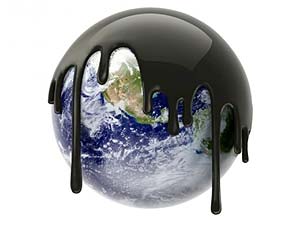
Neil Zusman (2010-08-24).








